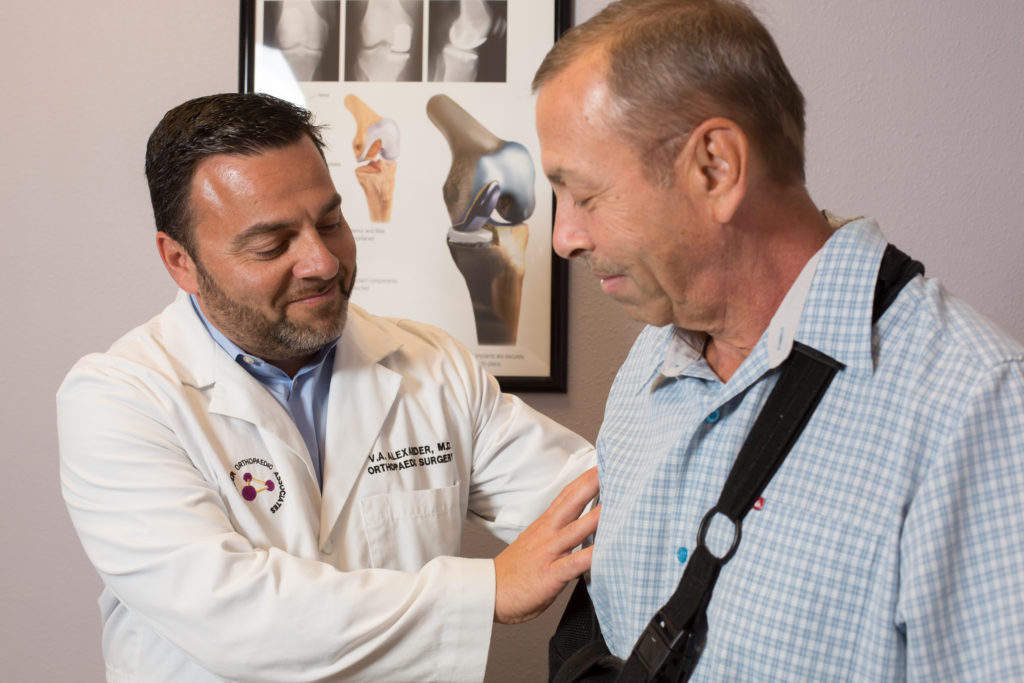Everything You Need To Know About Total Shoulder Replacement Surgery

The shoulder — made up of the clavicle (collar bone), upper arm bone (humerus), and the shoulder blade (scapula) — is the body’s most mobile joint. That also makes it the most vulnerable to injury. Shoulder injuries can result from falls, accidents or overuse, and the most common ailments are tendon issues, instability, arthritis and fractures.
Pain, limited movement or weakness in the shoulder can make even simple tasks difficult or impossible. The good news, though, is even the most complicated shoulder issues can be addressed with treatments ranging from simple activity changes to total shoulder replacement.
Common shoulder conditions and treatments
Unless a patient’s injury is severe and in obvious need of immediate surgery, the usual course of treatment is to start conservatively. Sometimes even simple rest, changes in activity or physical therapy can result in success. Cold weather can exacerbate shoulder pain, which can be relieved with light stretching or applying heat packs. If surgery is required, however, many shoulder injuries can be repaired via arthroscopy, a minimally invasive procedure that uses small incisions and a camera to make repairs. Rotator cuff injuries, shoulder dislocation, and instability are all candidates, and our surgeons have pioneered procedures that can treat even more types of shoulder injuries. After most arthroscopic procedures, patients undergo physical therapy to regain strength and range of motion.
When it’s time for total shoulder replacement
While conservative treatment is always the first choice, about 53,000 Americans undergo total shoulder replacement surgery, or arthroplasty, every year. Candidates usually suffer from severe pain or limited mobility that has not responded to other treatments.
One of the most common reasons for total shoulder replacement surgery is osteoarthritis, which causes gradual wear and tear of the cartilage that helps the bones glide smoothly. Over time and with repeated stress, the cartilage can become so thin that the bones start to grind against each other. Most common in patients over age 50, it causes severe pain and its development can’t be prevented. Other reasons for shoulder replacement include severe fractures and rotator cuff injuries that can’t otherwise be adequately repaired.
If you think you could be a candidate for shoulder replacement, talk to an experienced orthopedic surgeon. Be sure to describe the intensity and consistency of your pain, triggers including rest, and previous treatments. The procedure is mostly likely to benefit you if your pain is bad enough to interfere with everyday activities, keeps you up at night, or if you have loss of motion or weakness that has not responded to other treatments.
What happens during a replacement
During total shoulder replacement surgery, the damaged bones and joint surfaces are replaced with prosthetics. First, a metal ball with a stem is placed into the shoulder socket. Next, the humerus is reattached to the new joint. We’ve found that patients see better mobility and function upon recovery using this technique, which we perform in an outpatient setting.
Another type of procedure is called reverse total shoulder replacement, and it’s used when the patient’s rotator cuff is not in good enough shape to hold the prosthetic in place. It can be performed as either inpatient or outpatient. Like arthroscopy, surgery is followed by weeks of physical therapy.
If shoulder pain is keeping you from even simple tasks, we can help. With the Alexander Outpatient Advantage for total joint replacement, you’ll see highly-trained experts, undergo your procedure in a state-of-the-art facility, and work with our mobile therapy team to prep your home for recovery and even check on you at home after your procedure. Contact us to get started.
